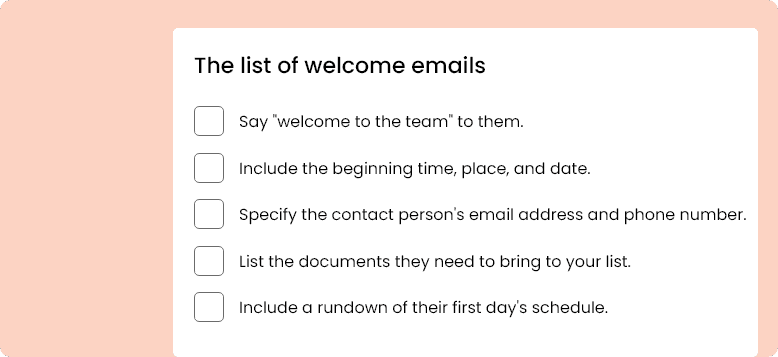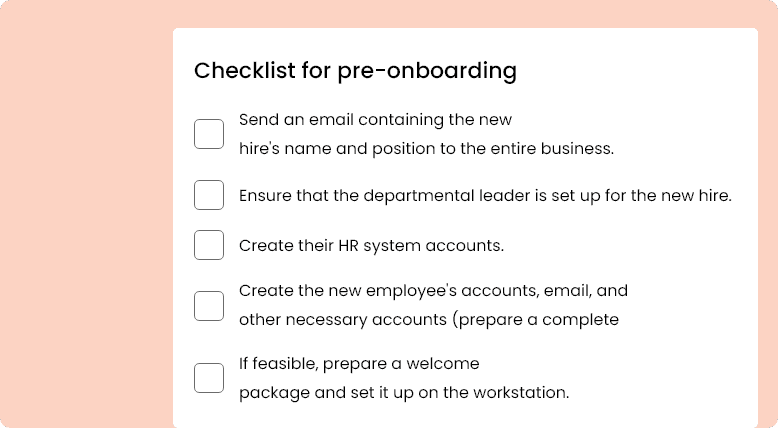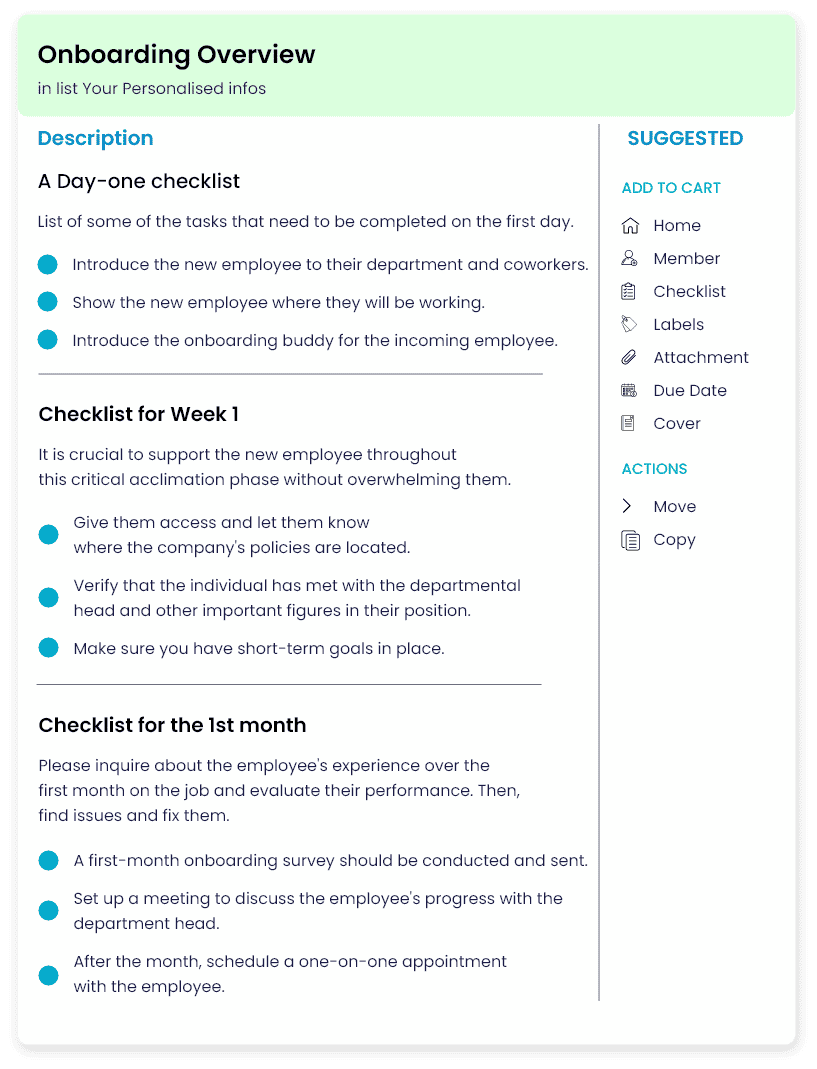Starting a new job can be overwhelming for anyone, and that’s why onboarding is crucial to make new hires feel welcome and ensure they have the resources they need to succeed. But unfortunately, many companies fail to do it. Research shows that only 13% of employees are satisfied with their onboarding, and 22% of employees leave before their first work anniversary. It can result in lower morale, engagement, and productivity. A good onboarding platform provides new employees with the necessary tools and resources to do their job effectively, reduces turnover, clarifies expectations, and promotes colleague relationships. This blog offers a comprehensive onboarding checklist for new hires template to help you organize the process and make new hires feel supported and welcome. Following these guidelines can create a positive first impression and ensure your new employees will be confident in their new roles.
What is onboarding?
Onboarding is the very first face of the company for a new hire. Hiring and integrating a new employee into your company system is known as onboarding. If you want fresh hires to understand and become a part of your team, onboarding is an effective, aligned and quick process. According to a Society for Human Resources Management study, nearly 70% of new hires said they’d be more likely to stay at a business for at least a few years if they had positive onboarding experience. Additionally, companies with a well-organized onboarding procedure reported a 50% increase in new team members’ productivity.
What is Onboarding Checklist?
An onboarding checklist is a helpful tool for hiring managers to keep track of the necessary steps to guide new hires through their first days and months at a company. In addition, it helps ensure that all the critical stages of the onboarding process for a particular job role are complete. However, simply completing an onboarding checklist template does not guarantee a successful onboarding experience for the new hire. The best onboarding process goes beyond checking off items on a list. It should balance meeting the employees’ needs, helping them assimilate into the company’s culture, and including practical moments that may have yet to be planned. A successful onboarding process template will provide the new hire with a solid foundation to build their career within the company and become a valuable team member.
4 Stages in Onboarding
Compliance, clarification, culture, and connection are the key elements that should be covered during an effective onboarding process. They don’t always occur on specific dates. However, it’s crucial to comprehend the differences between these phases.
- ComplianceYour new employee will complete paperwork, review employee handbooks, and generally learn about organizational policies and practices, such as how to request time off or when their insurance coverage starts.
- ClarificationDuring this stage, it is made sure that new hires are aware of the short-term and long-term activities that may be assigned to them and the daily chores they will be expected to do. They must comprehend how the rest of the organization supports and is supported by their duties.
- CultureThis stage clarifies how the business functions outside the written policies for new hires. Managers should make an effort during this time to make sure new hires are familiar with company policies.
- ConnectionThis is usually the most challenging and time-consuming phase because it entails assisting new employees in developing relationships with their coworkers and other employees. A successful onboarding process goes beyond simply introducing people; managers should foster cordial, constructive interactions in official and informal settings.
How to make an onboarding checklist?
A successful employee onboarding process comprises a variety of formal and informal interactions, making it challenging to keep onboarding tasks organized. On the other hand, writing an onboarding checklist is as easy as putting pen to paper. Of course, producing interesting materials is ideal if you repeatedly want to replicate a successful onboarding experience. Here are 4 practical steps to follow to establish an actionable checklist for a successful onboarding procedure:
Measure the necessities of the position
Before creating your onboarding checklist template, verifying whether your company has existing guidelines for the position is essential. Always speak with current employees in the role and gather information about their onboarding experience, including the details they received during their initial weeks. If the position is new to the company, research job postings from other organizations to identify the skills and qualifications typically required.”
Divide the onboarding templates into sections
To make things easier and more organized during the onboarding process, it’s a good idea to break your templates into different sections for each stage. You might need different sections depending on the job and how your company does things. When creating your onboarding plan template, setting goals for the new employee’s first day, week, and month on the job is helpful. This way, they’ll clearly understand what’s expected of them and what they need to accomplish.
Onboarding Checklist for New Hires’ First Day
To ensure a successful onboarding process, the following items should be included in the onboarding checklist template for new hires’ first day:
-
Welcome and Introduction
Welcome the new hire to the team and make them feel at home. Explain their role’s expectations and goals based on the information you collected from their manager.
-
Provide training resources
Provide the new hire with any necessary training materials, either in-house or online. Also, provide them with the login information required to start their training.
-
Mentorship Program
Assign an experienced team member to be the new hire’s manager. This person assists the new joinee through their first few weeks on the job and shows them the ins and outs of their job responsibilities.
Designate responsibilities for their first week.
To further ease the onboarding process, include a section on the onboarding templates focusing on the new hire’s first week. In addition, below are some standard checklist items that can be adapted to the new hire’s role and field:
-
Set Deadlines
It is essential to define a complete submission or turn-in date for the first project and ensure the new hire delivers it to you or another supervisor.
-
Expectations for the First Month
It’s important to outline specific performance expectations or completed tasks for the new hire to achieve over the next month. It can be based on their job description or a plan for their development if you need to familiarize yourself with their role.
Some Checklists for Onboarding
Include the following items in your checklist to simplify your onboarding procedure:
Wrapping Up!!
A better, happier workforce is the outcome of an efficient employee onboarding platform. However, the multiplicity of official and informal interactions during onboarding makes it challenging to keep onboarding tasks organized—hence we created a an Onboarding checklist template thinking about the four Cs. Our checklists can act as a guide for you to understand how you can standardize your onboarding process. It is imperative to encourage the new employee and provide means to understand the company, brand and teams he has to work with without overburdening them. Onboarding a new employee involves several specific steps that should be tailored to each hire. Pre-boarding activities, onboarding and 90 days post onboarding are crucial to have a good impression about the organization and to make the new hire get all the information about his work goals and how to keep himself aligned to business goals.















